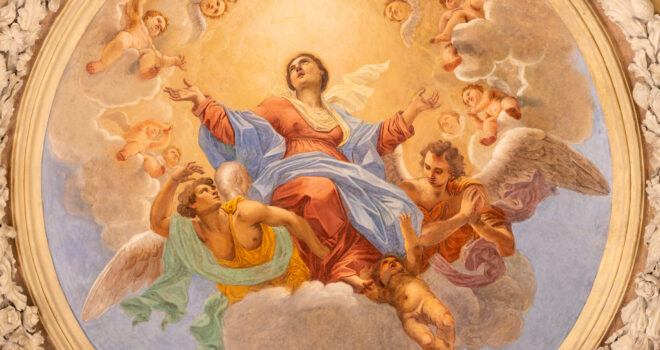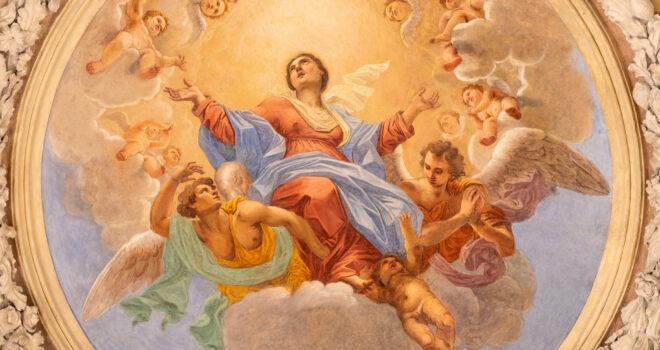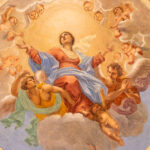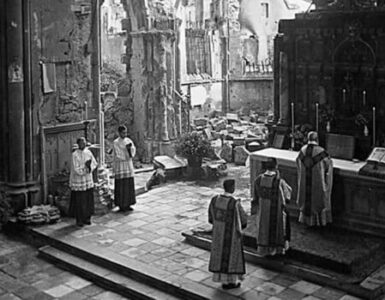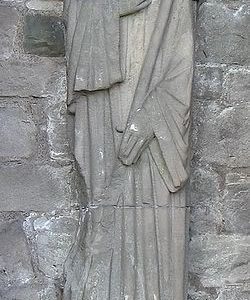Saint Paul preached that, because of our union with Jesus, we already mystically participate in His ascension. The Father has “raised us up with him, and made us sit with him in the heavenly places” (Eph 2:6). Paul saw how what begins in us spiritually is meant to become a bodily reality. “If the Spirit of him who raised Jesus from the dead dwells in you, he who raised Christ Jesus from the dead will give life to your mortal bodies also through his Spirit who dwells in you” (Rom 8:18; cf. Eph 1:18-21). In Mary’s assumption, the Church already sees the realization of this promise – the Church’s own bodily participation in Christ’s ascension.
The Catechism reminds us that “Christ enables us to live in him all that he himself lived, and he lives it in us” (CCC 521). This extends to His Paschal Mystery, which culminated in His ascension and exaltation at the Father’s right hand. We already experience this reality spiritually; when we pray we come boldly to God’s throne, surrounded by myriads of angels and saints (Heb 4:16; 12:22-24). Saint Paul tells us that we will experience it bodily at Christ’s Second Coming: “The Lord himself will descend from heaven with a cry of command . . . And the dead in Christ will rise first; then we who are alive, who are left, shall be caught up together with them in the clouds to meet the Lord in the air; and so we shall always be with the Lord” (1 Thes 4:16–17).[1] This event was foreshadowed in the Old Testament, in the assumptions of Enoch (Gn 5:24; Heb 11:5) and Elijah (2 Kings 2:11–12), and in the resurrection of certain saints when Christ achieved our redemption: “many bodies of the saints who had fallen asleep were [also] raised, and coming out of the tombs after [Jesus’s] resurrection they went into the holy city and appeared to many” (Mt 27:52–53).
Pope Pius XII has, by definitively proclaiming the truth of Mary’s assumption, assured us that God is faithful to His word and character. Would the God who assumed Enoch and Elijah into glory as a reward for faithfully walking beside Him (Gen 5:24), allow the flesh of His most faithful Mother to rot in the grave? Would the New Adam refuse to share the fullness of His victory with the New Eve, bone of His bone and flesh of His flesh (see Gn 2:23; 3:15; Jn 19:26; Rev 12:1-5; Eph 5:25-29)? Would the Son Who applied the merits of His redemption to Mary at her conception, refuse to apply those same merits at her life’s end? God made her the Kecharitōmenē, the one absolutely filled with His grace (Lk 1:28); and, as Cardinal Ratzinger concluded, “where the totality of grace is, there is the totality of salvation.” In Mary’s “pure ‘Yes,’ death, sin’s jailor, has no place.”[2]
The Church, in its yearly celebration of Mary’s assumption, invites us to be permeated by the truth that what has begun in Christ – His resurrection and the glorification of His humanity – will be realized in us (see CCC 966). The Apostle John expressed his awe at this truth, “Beloved, we are God’s children now; it does not yet appear what we shall be, but we know that when [Christ] appears we shall be like him, for we shall see him as he is. And every one who thus hope in him purifies himself as he is pure” (1 Jn 3:2-3). Mary prays for us, asks Jesus to impart the grace moving us to love Him with the purity of her immaculate heart (Mt 5:8).She intercedes that we will, “Set [our] minds on things that are above, not on things that are on earth. For [we] have died, and [our] life is hidden with Christ in God. When Christ who is our life appears, then [we] also will appear with him in glory” (Col 3:1–4) – just as she did, “a woman clothed with the sun, with the moon under her feet, and on her head a crown of twelve starts” (Rev 12:1). She is, in the words of John, “a great sign” to us all.
Adapted from Shane Kapler’s The Biblical Roots of Marian Consecration: Devotion to the Immaculate Heart in Light of Scripture (TAN Books, 2022).
[1] This is not to be confused with the belief among some of our separated brethren known as “the Rapture.” For a Catholic critique of this belief, please go here.
[2] Joseph Ratzinger, Daughter Zion (San Francisco: Ignatius Press, 1983), 78.


